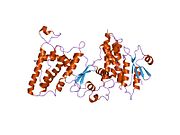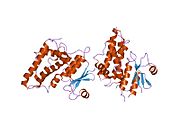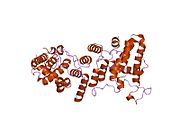Biology:CLIC1
From HandWiki
Short description: Protein-coding gene in the species Homo sapiens
 Generic protein structure example |
Chloride intracellular channel protein 1 is a protein that in humans is encoded by the CLIC1 gene.[1][2]
Chloride channels are a diverse group of proteins that regulate fundamental cellular processes including stabilization of cell membrane potential, transepithelial transport, maintenance of intracellular pH, and regulation of cell volume. Chloride intracellular channel 1 is a member of the p64 family; the protein localizes principally to the cell nucleus and exhibits both nuclear and plasma membrane chloride ion channel activity.[2]
Interactions
CLIC1 has been shown to interact with TRAPPC2.[3]
See also
References
- ↑ "Molecular cloning and expression of a chloride ion channel of cell nuclei". J Biol Chem 272 (19): 12575–82. Jun 1997. doi:10.1074/jbc.272.19.12575. PMID 9139710.
- ↑ 2.0 2.1 "Entrez Gene: CLIC1 chloride intracellular channel 1". https://www.ncbi.nlm.nih.gov/sites/entrez?Db=gene&Cmd=ShowDetailView&TermToSearch=1192.
- ↑ Fan, Libin; Yu Wei; Zhu Xueliang (Apr 2003). "Interaction of Sedlin with chloride intracellular channel proteins". FEBS Lett. (Netherlands) 540 (1–3): 77–80. doi:10.1016/S0014-5793(03)00228-X. ISSN 0014-5793. PMID 12681486.
Further reading
- Singh H (2010). "Two decades with dimorphic Chloride Intracellular Channels (CLICs)". FEBS Letters 584 (10): 2112–21. doi:10.1016/j.febslet.2010.03.013. PMID 20226783.
- "Large scale cDNA sequencing for analysis of quantitative and qualitative aspects of gene expression". Nat. Genet. 2 (3): 173–9. 1994. doi:10.1038/ng1192-173. PMID 1345164.
- "Analysis of 2166 clones from a human colorectal cancer cDNA library by partial sequencing". Hum. Mol. Genet. 4 (1): 37–43. 1995. doi:10.1093/hmg/4.1.37. PMID 7711732.
- "Redox Regulation of CLIC1 by Cysteine Residues Associated with the Putative Channel Pore". Biophys. J. 90 (5): 1628–1638. 2006. doi:10.1529/biophysj.105.072678. PMID 16339885. Bibcode: 2006BpJ....90.1628S.
- "A catalogue of genes in the cardiovascular system as identified by expressed sequence tags". Proc. Natl. Acad. Sci. U.S.A. 91 (22): 10645–9. 1994. doi:10.1073/pnas.91.22.10645. PMID 7938007. Bibcode: 1994PNAS...9110645L.
- "Oligo-capping: a simple method to replace the cap structure of eukaryotic mRNAs with oligoribonucleotides". Gene 138 (1–2): 171–4. 1994. doi:10.1016/0378-1119(94)90802-8. PMID 8125298.
- "Genomic structure of a novel chloride channel gene, CLIC2, in Xq28". Genomics 45 (1): 224–8. 1997. doi:10.1006/geno.1997.4922. PMID 9339381.
- "Construction and characterization of a full length-enriched and a 5'-end-enriched cDNA library". Gene 200 (1–2): 149–56. 1997. doi:10.1016/S0378-1119(97)00411-3. PMID 9373149.
- "NCC27, a homolog of intracellular Cl− channel p64, is expressed in brush border of renal proximal tubule". Am. J. Physiol. 274 (6 Pt 2): F1140–9. 1998. doi:10.1152/ajprenal.1998.274.6.F1140. PMID 9841507.
- "A 29 kDa intracellular chloride channel p64H1 is associated with large dense-core vesicles in rat hippocampal neurons". J. Neurosci. 19 (8): 2919–28. 1999. doi:10.1523/JNEUROSCI.19-08-02919.1999. PMID 10191309.
- "Genes encoding three new members of the leukocyte antigen 6 superfamily and a novel member of Ig superfamily, together with genes encoding the regulatory nuclear chloride ion channel protein (hRNCC) and an N omega-N omega-dimethylarginine dimethylaminohydrolase homologue, are found in a 30-kb segment of the MHC class III region". J. Immunol. 163 (1): 278–87. 1999. doi:10.4049/jimmunol.163.1.278. PMID 10384126.
- "Identification of a Novel Member of the Chloride Intracellular Channel Gene Family (CLIC5) That Associates with the Actin Cytoskeleton of Placental Microvilli". Mol. Biol. Cell 11 (5): 1509–21. 2000. doi:10.1091/mbc.11.5.1509. PMID 10793131.
- "Functional characterization of the NCC27 nuclear protein in stable transfected CHO-K1 cells". FASEB J. 14 (9): 1171–8. 2000. doi:10.1096/fasebj.14.9.1171. PMID 10834939.
- "The nuclear chloride ion channel NCC27 is involved in regulation of the cell cycle". J. Physiol. 529 (3): 541–52. 2001. doi:10.1111/j.1469-7793.2000.00541.x. PMID 11195932.
- "Crystal structure of a soluble form of the intracellular chloride ion channel CLIC1 (NCC27) at 1.4-A resolution". J. Biol. Chem. 276 (48): 44993–5000. 2002. doi:10.1074/jbc.M107804200. PMID 11551966.
- "Recombinant CLIC1 (NCC27) assembles in lipid bilayers via a pH-dependent two-state process to form chloride ion channels with identical characteristics to those observed in Chinese hamster ovary cells expressing CLIC1". J. Biol. Chem. 277 (29): 26003–11. 2002. doi:10.1074/jbc.M203666200. PMID 11978800.
- "AKAP350 at the Golgi apparatus. II. Association of AKAP350 with a novel chloride intracellular channel (CLIC) family member". J. Biol. Chem. 277 (43): 40973–80. 2002. doi:10.1074/jbc.M112277200. PMID 12163479.
- "Generation and initial analysis of more than 15,000 full-length human and mouse cDNA sequences". Proc. Natl. Acad. Sci. U.S.A. 99 (26): 16899–903. 2003. doi:10.1073/pnas.242603899. PMID 12477932. Bibcode: 2002PNAS...9916899M.
- "Interaction of Sedlin with chloride intracellular channel proteins". FEBS Lett. 540 (1–3): 77–80. 2003. doi:10.1016/S0014-5793(03)00228-X. PMID 12681486.
- "The DNA sequence and analysis of human chromosome 6". Nature 425 (6960): 805–11. 2003. doi:10.1038/nature02055. PMID 14574404. Bibcode: 2003Natur.425..805M.
- "The intracellular chloride ion channel protein CLIC1 undergoes a redox-controlled structural transition". J. Biol. Chem. 279 (10): 9298–305. 2004. doi:10.1074/jbc.M308444200. PMID 14613939.
- "Functional reconstitution of mammalian 'chloride intracellular channels' CLIC1, CLIC4 and CLIC5 reveals differential regulation by cytoskeletal actin". FEBS J. 274 (24): 6306–6316. 2007. doi:10.1111/j.1742-4658.2007.06145.x. PMID 18028448.
External links
- CLIC1+protein,+human at the US National Library of Medicine Medical Subject Headings (MeSH)
- Human CLIC1 genome location and CLIC1 gene details page in the UCSC Genome Browser.
This article incorporates text from the United States National Library of Medicine, which is in the public domain.
 |





